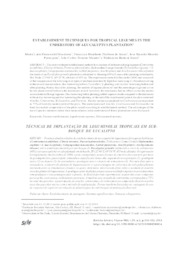Establishment techniques for tropical legumes in the understory of a eucalyptus plantation.
Establishment techniques for tropical legumes in the understory of a eucalyptus plantation.
Author(s): NICODEMO, M. L. F.; SOUZA, F. H. D. de; PEZZOPANE, J. R. M.; MENDES, J. C. T.; BARIONI JUNIOR, W.
Summary: This study evaluated establishment methods for a mixture of herbaceous forage legumes [Centrosema acutifolium, Clitoria ternatea, Pueraria phaseoloides, Stylosanthes Campo Grande (Stylosanthes capitata + S. macrocephala), Calopogonium mucunoides, Lablab purpureus, Arachis pintoi, and Aeschynomene villosa] under the shade of an Eucalyptus grandis plantation submitted to thinning (40%) 8 years after planting in Anhembi, São Paulo (22°40?S, 48°10?W, altitude of 455 m). The experiment started in December 2008 and consisted of the comparison of the following four types of seed incorporation by light disc harrowing: (1) broadcast sowing without seed incorporation; disc harrowing before (2) or after (3) planting, and (4) disc harrowing before and after planting. Ninety days after planting, the number of legume plants/m² and the percentage of ground cover by the plants varied between the treatments tested; however, the treatments had no effect on the dry matter accumulation of forage legumes. Disc harrowing before planting yielded superior results compared to the treatments without disc harrowing and disc harrowing after planting. At the end of the experimental period, the plots contained Arachis, Centrosema, Stylosanthes, and Pueraria. The dry matter accumulated by Centrosema corresponded to 73% of total dry matter yield of the plots. The participation of Arachis, Centrosema and Stylosanthes in final dry matter composition of the plots varied according to establishment method. The advantages of the use of species mixtures rather than monocultures in the understory of forest plantations were discussed.
Publication year: 2015
Types of publication: Journal article
Observation
Some of Embrapa's publications are published as ePub files. To read them, use or download one of the following free software options to your computer or mobile device. Android: Google Play Books; IOS: iBooks; Windows and Linux: Calibre.
Access other publications
Access the Agricultural Research Database (BDPA) to consult Embrapa's full library collection and records.
Visit Embrapa Bookstore to purchase books and other publications sold by Embrapa.

